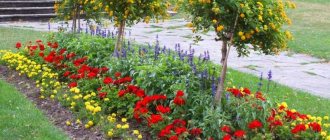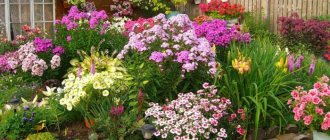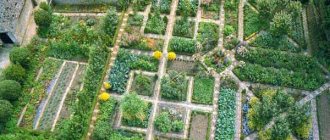The essence of mixborder
A mixborder is understood as a complexly composed bordering flower bed. Different types of plants are included within the boundaries of a single composition. On a single area they can connect together:
- annual and perennial flowers;
- shrubs;
- herbs;
- trees.
The composition includes clearly distinguishable specimens with different colors, sizes, and leaf formats. For the first time, such mixtures began to be created in France. The option is most widespread in traditional English gardens.
Examples of decorative perennial mixborder design
An analogue of a house wall or a fence in nature is a forest wall. The height of plants at the edge decreases with distance from the forest wall and turns into a meadow. The same in the garden. We plant large shrubs (or even trees) near the wall of the house or near the fence, then medium-sized ones and finish with low herbaceous plants or shrubs that “flow” into the plane of the lawn.
The edge as an analogue allows us to discuss some of the mistakes that we make when creating compositions of a one-sided view. After all, in our work we are obliged to take into account the laws of this community.
Here is one example of a beautiful mixborder in a garden composition. In nature, you are unlikely to see a path running exactly along the perimeter of the edge. She then slips away into the forest, then comes out into the clearing.
And in gardens, the path almost always becomes a boundary element between the plane of the lawn and the linear composition of a one-way view. This is perfectly acceptable, but not particularly interesting.
When creating mixborders, try to play with the situation when the axis of the path and the border line between the lawn and the mixborder do not coincide. Let the path either enter the composition, passing between perennials, or again go out onto the lawn. This solution can be especially effective in small areas.
A winding path that awakens curiosity fits much better into the Russian person’s idea of what a garden should be like. European “gardens in the palm of your hand,” which are easy to appreciate at a glance, usually seem a bit boring to us.
As you can see in the photo, mixborders in landscape design look very organic:
Classic English
The traditional mixborder combines English stiffness, strict lines and natural freedom. Often these are mixborders with roses and peonies. On a single territory there are low-growing coniferous trees, flowering and green shrubs, wildflowers and cereals. Boxwood and thuja here successfully coexist with dahlias and phlox. The crowns of trees and bushes must be trimmed. Curly tops are welcome.
What is a mixborder
A flower garden in which several types of plants are planted in a stepped order is a mixborder. The literal translation from English is “mixed border” . Just like a flower border, a mixborder has an elongated shape: its length always exceeds its width by at least 2 times. The length of the flower bed is not limited and can correspond to the length of the path, and the average width is 1.5-2 m.
Plants in a mixborder are selected in such a way that their flowering alternates throughout the season, from early spring to late autumn. The start is set in early spring, when primroses appear from under the snow, followed by tulips and other bulbous plants, then herbaceous perennials, shrubs and shrubs, and chrysanthemums and asters bring the finishing line.
Selecting the color of the components
Mixborders from perennials must be carefully shaped according to the color of the plants. The composition of the palette is usually subject to the following principles:
- Contrast. Plants of different color palettes are planted nearby. You can pair white with red, blue with yellow, pink with blue. It is important to harmoniously match the shades used.
- Monochrome. Components of a flower bed in a single color. Use the difference between similar shades. It is good to combine purple with lilac, red with orange, blue with cyan.
- Polychrome. Use several complementary shades. The green base and white accents that make up the masses in a single color scheme look good. It's important not to overdo it. More than 5 shades immediately creates diversity.
When forming a flower bed from annuals, it will also not be superfluous to adhere to the rules for selecting colors. If an unsatisfactory result is achieved, it is easier to correct the situation by replacing the technology in the next season.
How to create a mixborder and design a composition (with video)
It should be noted that a one-sided composition and a floral mixborder as its special case lend themselves to stylization, perhaps better than any other element of the garden.
- Firstly, the mixborder rarely falls into the same angle of view as the house. Namely, the house most often limits us in our ability to stylize any part of the garden.
- Secondly, the wall or fence along which mixborders are most often laid out can be successfully decorated, setting the tone for the chosen style. Any stylization, in fact, is nothing more than a game of associations.
How to create mixborders in different styles? If you want to show Japan, choose an alternative to bamboos, Japanese maples, and mosses. If you want to show off Italy, look for plants similar to cypresses, olives, and pine trees.
The same goes for walls: embody associations with a country wall, a wall in a Japanese garden, or a wall with an English mixed border in the background.
However, do not forget that when styling when creating a garden mixborder, it is easy to get carried away and slip into kitsch. When the “rustic” composition is complemented by plastic geese, and wheels and grips are hung on the fence, like on a fire shield, it looks vulgar.
Perhaps the listed accessories would be quite suitable for decorating the patio of a cafe, but they are unlikely to be suitable for a small garden. Of course, we can use small architectural forms - sculpture, lanterns, etc. - but very carefully. Still, it is better when the natural component prevails in a stylized landscape, and the architecture is subordinate to it.
It is very important to take into account the context in which the composition is being built. Pay attention to your surroundings, look at what is growing behind the fence, on the right, on the left. Whatever one may say, you can’t style a spruce forest like the Mediterranean, and in the hot sun you won’t get a romantic white garden.
We cannot ignore the conditions of our site, nor what is located beyond its borders. Let’s say that behind the fence there is a neighbor’s orchard with tall old apple trees or an outskirts area, and behind it there is a forest. The fence is solid, and at its foot you begin to create a composition of a one-way view, without connecting it in any way with the views on the other side of the fence. Even if the view is completely hidden, the virtual border between the polar compositions in front of the fence and behind it does not disappear.
This is not about planting Christmas trees from the forest or apple trees in your garden, like your neighbor’s. But a smooth transition is necessary, and it can be ensured through simple actions.
A great idea when creating a mixborder is to divide herbaceous and woody plants into groups according to physiognomic type. Some can be safely classified as “village”, others as “forest”, others as “exotic”, etc.
To design your mixborder as harmoniously as possible, use this advice. If you want to create an exotic flower garden against the background of a neutral Central Russian forest, use shrubs or trees that, according to their physiognomic type, fall into the “forest” group.
Take not species, but exotic varieties, for example, split-leaved or golden-leaved. An unusual “forest” plant will smooth out the contrast.
Naturally, in this case the fence will not go anywhere. But he will no longer separate the two alien environments.
The impression will be as if the fence cuts off a piece of forest that is visible behind it, and the flower beds are a natural continuation of the edge. As a rule, such a picture is natural and harmonious.
Watch the video “Creating mixborders”, which shows the best ideas for designing such flower beds:
Determining the location
A border flower bed is made along the edge of something. It could be:
- house facade;
- fence;
- track.
The easiest way to build a mixborder with your own hands is at the base. A flower garden of this format is also planted on a slope. The absence of bright sunlight is important.
Mixborder schemes
Every flower garden has plants that form its basis. These are the ones you should start with when drawing up a mixborder scheme. How many points with dominant plants there will be, depending on the area of the plot allocated for the flower garden. The diagram shows the planting site of the dominant species in bright color, and other vegetation is distributed around it.
Mixborder with roses
The Queen of Flowers occupies a dominant position in the mixborder. The rose occupies a central position, and the entire composition is built around it. Hostas, including those with variegated foliage, can be placed in the foreground. Their flowering does not begin until late summer, so hostas will not distract attention from the rose bushes throughout the season.
Combination of roses with hostas
Roses are planted in a continuous line or dotted. In the second case, they are interspersed with herbaceous perennials with flowers of a contrasting shade to the roses. Also, they should not exceed roses in height. Any shrubs with decorative foliage and small flowers are selected as a background plant.
Advice. Rose bushes don't like being crowded. Their branches should not come into contact with neighboring species.
Mixborder with hydrangea
Mixborder with tree hydrangea
The graceful hydrangea is magnificent when in bloom and is no less valuable as a garden decoration than a rose. It has the amazing property of being combined with plants of a wide variety of designs, both majestic and simple. This feature allows you to use hydrangea in mixborders of radically different styles.
Hydrangea with hostas
Hydrangea does not bloom for as long as a rose, so the principle of creating a mixborder with it is somewhat different. Plants are planted in it, the flowering dates of which do not coincide with the flowering of hydrangea. Perennials that do not pretend to be exotic are suitable: cornflower, erigeron, cinquefoil. Since hydrangea flowers do not have bright colors, other plants with striking colors and long flowering, for example, gaillardia, coreopsis, and rudbeckia, can be used in the mixborder.
Continuous flowering mixborder
The most difficult thing in creating a mixborder is to create the impression of continuous flowering. The task is not only to select plants of different flowering periods, but also to correctly distribute them in the flower garden. A big mistake is the location, when one part of the mixborder is constantly fragrant with blooming flowers, while the other looks like a “gray” (in this case, “green”) mouse in comparison.
Continuity of flowering is achieved by using different types of perennials, which are grouped into several plants. Such groups are distributed in the flower garden at a certain distance, and there can be 2-3 or more of them, depending on the length of the mixborder. It is desirable that alternating groups of plants differ in the size of the leaves, the shape of the bush, and the shade of the flowers.
Table of flowering dates for some perennials and bulbous plants:
| Flowering period | Plant species |
| April May | Muscari, Pushkinia, tulips, daffodils, lumbago, hellebore, sedum, Caucasian rhizome |
| May June | Peonies, large-leaved brunnera, bearded iris, catnip, aubrietta, cinquefoil, aquilegia, wood anemone, geranium, ornamental onion, lilies, loosestrife |
| June July | Coreopsis, astilbe, red day, yarrow, Caucasian dronicum, liatris spikelet, spur, erigeron, phlox, echinacea |
| July August | Delphinium, gaillardia, rudbeckia, sunflower, monarda, solidago, angustifolia lavender, yucca, coreopsis, rudbeckia |
| Aug. Sept | Sedum prominent, bellflower, scabiosa, sedum squeaky, hosta |
| September October | Perennial aster, Korean chrysanthemum, black cohosh, aconite, |
Rules for combining plants
The correct choice of neighboring species is the key to the success of the design. It is important to select plants according to the following parameters:
- height;
- decorativeness;
- flowering period;
- features of care.
With the right approach, the flowerbed will turn out surprisingly coordinated. The plants will not wither, the plantings will delight you with continuous flowering.
Understanding how to make a mixborder correctly is important for any gardener. The flowerbed option is popular and easy to implement. Such a flower garden will be an ideal solution for different areas.
- Do-it-yourself landscaping of the site - interesting ideas and creative options for designing a summer cottage and adjacent area (135 photos)
- Do-it-yourself rabatka: 145 photos on how to create a cool shape and choose flowers for a rabatka
- DIY rock garden - 115 photos, diagrams, projects and video master class on how to create a beautiful rock garden
Making garden flower mixborders at the dacha with your own hands (with photo)
Height. How do you build a one-way view composition when creating a mixborder with your own hands?
We select the height of its elements taking into account that the line of the upper edge turns out beautiful. At the same time, we are not always able to appreciate the beauty created. The fact is that we see the composition not entirely, but partially (only the lower or upper part), because we are too close to it.
For a holistic perception of a beautiful mixborder, it is necessary that the distance from the point of view to the composition be at least two of its heights. Of course, you can use even very large trees, but keep in mind that they will only “work” as a background. Only the owner of the neighboring plot, which is located at a greater distance from the composition, will be able to see everything as a whole.
In addition, when installing a mixborder in a dacha, the height of the fence or wall in front of which the composition is built is not always taken into account. If the top edge of the wall does not fall into the viewing angle, you can build a composition of any height, but if it is visible, then the edge (for example, the top edge of a fence) must be taken into account.
Before making a mixborder, to make design easier, take photographs of the garden from those points from where you are going to admire the composition of a one-way view. In this case, you do not need to use the function of zooming in or out of the image. It is best to take photographs when there are no leaves on the trees: you can immediately see what will happen if a plant is removed.
Let's look at a case where a person creates a mixborder of shrubs, trees and perennials against the backdrop of a long fence. Often this is done for the sole purpose of getting rid of monotony. But in most cases the monotony is preserved, because plants and other elements of the composition do not intersect the upper edge of the fence anywhere. At the same time, as soon as any plant crosses the edge, the feeling of monotony will disappear, since we will see not one long line, but two short ones.
It is important that the upper edge of the one-way view composition when creating a mixborder from ornamental shrubs is not straight. Remember again what a forest edge looks like.
The tops of the plants are located at different heights, they form a beautiful line. In garden compositions that have little depth, it is difficult to play with changes in height from the fence to the front edge of the composition.
Therefore, when selecting plants for a mixborder, you should work linearly, that is, create a graphically interesting outline against a certain background.
Remember the rule for creating mixborders: the shallower the depth, the more obvious the fluctuations in height along the wall should be. Otherwise, you will end up with a “brick,” that is, there will be nothing for the eye to grab onto, nothing to isolate. In other words, we will not beat up the wall, but will create another one parallel to it, only from plants, and the same monotonous one.
Depth. It is clear that the height of the composition elements should decrease as they approach the observer. But many gardeners simply calculate heights mathematically. Place the plants in piles: high, medium, low. Then these heaps are planted alternately along the fence: a high row, a middle row, a low row. This is the wrong approach.
As you can see in the photo, in a mixborder of shrubs and perennials, the composition will look more natural and impressive if some plants in the background fall into the middle, and some of the middle ones come to the fore:
It is very good when individual low plants are among the ground cover, transforming the composition into the plane of the lawn.
Another rule: rows of plants should not be parallel. After all, in nature there are no straight lines. Even in the case when the composition of a one-way view is built between a fence and a path parallel to each other, it should not repeat these lines. It is also important to avoid parallels within the composition itself.
By the way, there is also a relationship between the width of the lines and the height of the composition of the decorative mixborder. As the width of the strip increases, the height of the plants should also increase (and vice versa). In nature, this dependence is visible to the naked eye; it is absolutely natural. But when designing flower beds, this condition is not always met. But when tall plants are planted in the narrow part of the composition, and short ones in the wide part, it looks unnatural.
Width. The width of the one-way viewing composition can be small and fit into a horizontal viewing angle of 30°. But more often it has a greater extent. It is difficult to imagine, for example, a mixborder that would completely fit into a 30-degree viewing angle. After all, a mixborder is a composition consisting of a number of consecutive paintings.
The problem is that many take the theory of building a long-term mixborder too literally. And this is not at all about creating several compositions and placing them next to each other. No, we are building one linear composition, but depending on which part a person is looking at, it has several, let’s say, faces - several complete, well-balanced parts. Please note that emphasis may shift during the review. For example, in one part of the composition a certain element plays a subordinate role, and in the neighboring part it becomes an accent.
When creating a mixborder, it is very important for both experienced flower growers and beginners to accurately build a hierarchy of elements. One must always dominate, the other must submit. The absence of main and subordinate elements in the composition is a gross mistake that nullifies all efforts to build a mixborder.
If there are main and subordinate elements, a person sitting on a bench looks left and right, up and down, identifies pictures (corresponding to a horizontal visual angle of 30°) and admires them.
It’s good when the accents, and therefore the pictures, change from season to season.
Look at the photo - in the mixborder in the garden in spring, flowering bulbs attract attention:
In autumn, the emphasis is on the bright colors of shrubs, in winter - on the expressive pattern of tree bark. Nature itself tells us that we need to make the most of the opportunity to change something, and not create static, for example, purely coniferous, compositions that are “the same color in winter and summer.”
Photo of a beautiful mixborder on a summer cottage
Tell your friends











